12 Common Mistakes To Avoid When Making Donuts

There's nothing like a homemade donut. Fluffy, slightly crisp, and lightly sweet (or really sweet, depending on how much glaze or sugar you coat it with): It's enough to make your mouth water just reading about it! To make these delightful desserts even more appealing, they are very easy to make. Unfortunately, though, it is also very easy to make mistakes while doing so.
If your donuts turn out hard, oily, or just otherwise not up to snuff, this article will help you figure out why. Usually, the solution is something as simple as letting your dough rise longer, mixing it more (or less), or approaching things in a different way. We will also let you in on a few little secrets about donut-making that will brings yours to a whole new level. So, whether you prefer fried donuts, baked donuts, cake donuts, or jelly-filled ones, we'll let you know what mistakes to avoid so that you can make your next batch your best one yet.
Read more: Cake Hacks Every Baker Will Wish They Knew Sooner
Mistake: Using Expired Yeast
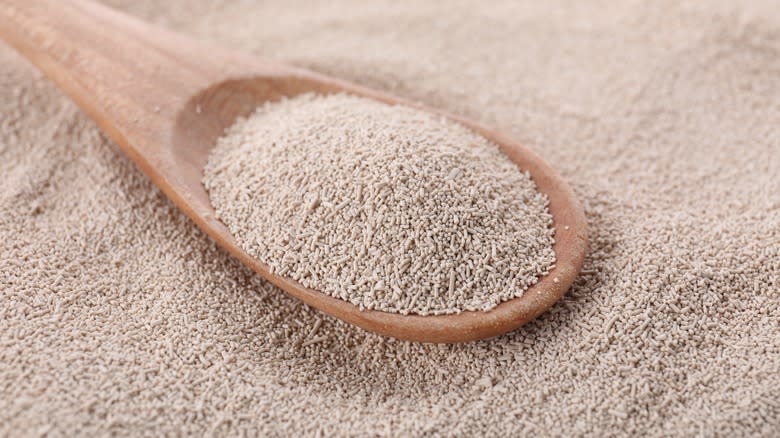
Yeast is a phenomenon in the baking world. It is responsible for some beautiful bread loaves, some breathtaking bagels, and some perfect pizza crust, not to mention some deliciously fluffy donuts. A lot depends on those little living microorganisms eating up the sugar and starch in your dough and producing gas from it, but home cooks make a lot of mistakes with yeast every day.
One of the most egregious of these errors is using yeast that has passed its expiration date. As we mentioned, yeast is a living thing, and if you try to use a package of yeast that has expired, the organisms living inside may have "expired" too. As in, died. And dead fungi (yes, yeast is a type of fungus!) don't eat sugar and starch, which means they won't produce the carbon dioxide needed to make your dough rise. Which, in turn, means that your donuts will stay flat and hard.
Keep in mind, however, that yeast doesn't have to have passed its expiration date to have gone bad. Improper storage can lead to air and/or moisture getting inside the package, which can also kill the yeast and keep your dough from rising. To check if your yeast is still active, add a bit of yeast and sugar to ½ cup of warm water. If, after around 10 minutes, bubbles have formed on the surface, the yeast is still ready to use. If not, it's better to open a fresh package.
Mistake: Forgetting About Cake Donuts
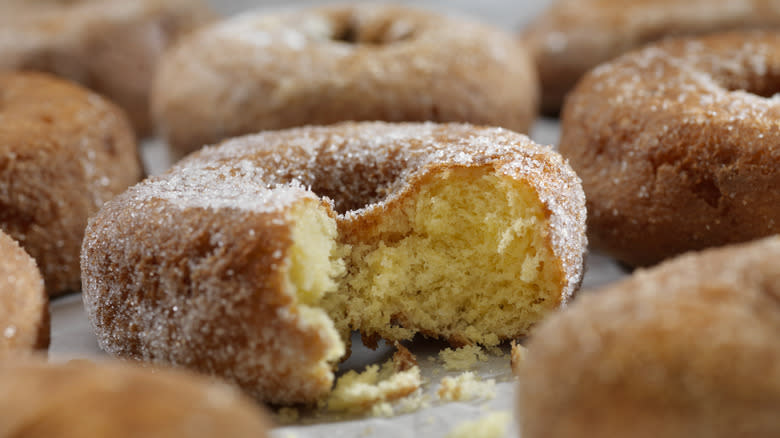
Yeast-risen donuts may be the most common type of donuts, but they are certainly not the only donut in town. Cake donuts are also a thing -- a really good thing! The main difference between cake donuts and fried donuts is that the latter uses yeast to rise while the former relies on a chemical leavener like baking soda or baking powder (or both). In addition to the baking powder or baking soda, cake donuts are made with flour, sugar, milk, eggs, salt, and shortening and typically see an addition of flavorings like vanilla, chocolate, cinnamon, or nutmeg. These ingredients are mixed together to form a batter, not a dough, so it will be thinner than raw yeast donuts. This makes the donuts cook faster than the yeast-risen variety and they absorb the frying oil more readily. When done right, they have a texture that is very dense and more moist than the "cake" they're named after.
Yeast donuts, on the other hand, use many of the same ingredients, but in different amounts. Since they contain yeast, they must be kneaded like bread and have to rise for several hours before they are ready to fry. While both donuts are great, some people prefer cake donuts because they are heartier and quicker to make. Since flavor can be more easily added to the batter, they can also be enjoyed without any glaze or topping.
Mistake: Thinking Donuts Can Only Be Fried
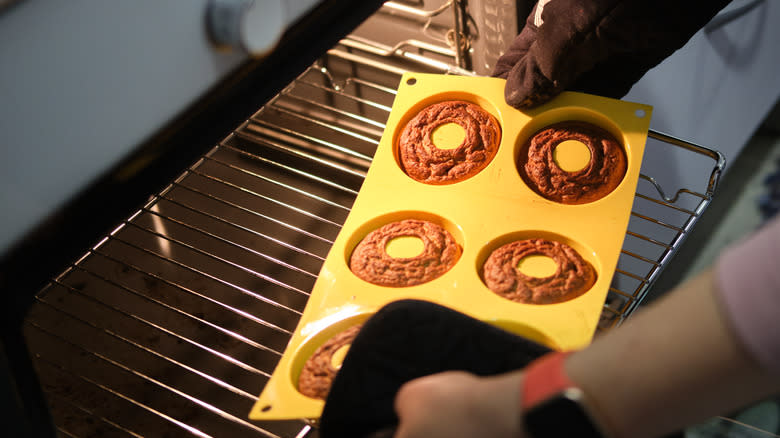
While some donut purists will tell you that the only real donut is a fried donut (and to be fair, even Merriam-Webster defines a donut as a "small usually ring-shaped piece of sweet fried dough"), there is more than one way to cook a donut. Donuts can also be baked for an arguably slightly healthier version that requires no close proximity to boiling hot oil. Two very big pluses, in our opinion!
If you can bake muffins, you can bake donuts. In fact, baked donuts even have many of the same ingredients: butter, sugar, eggs, baking powder, baking soda, spices like nutmeg or cinnamon, salt, vanilla extract, flour, and milk. Simply mix the ingredients together to make a thick batter. This process will be more convenient if you have a dedicated donut pan, but you can also make baked donuts by piping rings with an icing bag onto a cookie sheet. Then bake them in the oven at 375 degrees F until golden brown. You can then top them with icing, sprinkles, cinnamon sugar, or any of your other favorite donut decorations. Yeast donuts can also be baked in a similar manner. Just don't forget to let them rise before putting them in the oven!
Mistake: Not Letting The Dough Rise
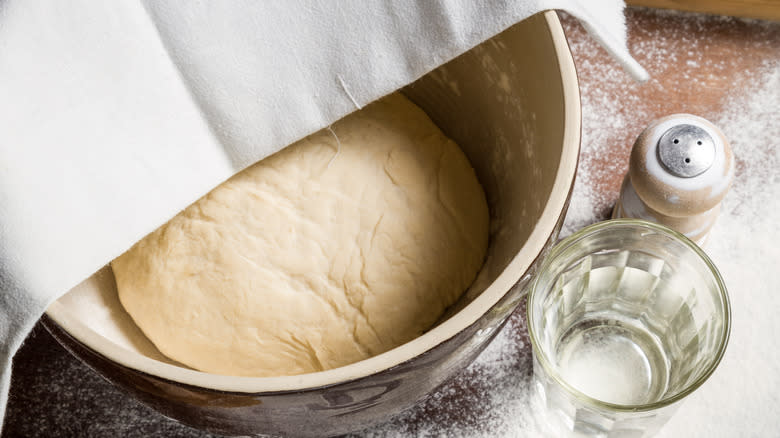
Thanks to the all-important yeast they contain, making donuts is a lot like making bread, at least up to the point where you tip them into the frying oil. Their dough requires kneading, either by hand or with a specialized mixer or bread machine, but even more importantly, it requires resting time.
The amount of time your dough needs to rest depends on what type of yeast you are using. But no matter whether you are using a quick-acting yeast or a slower-acting one, you will still need to give the dough time to rise. During this time, a chemical change happens inside the bread as the yeast consumes the sugars, digests them, and produces gas. That gas makes the dough get filled with pockets of air, which make the resulting donuts fluffy and light.
For best results, your dough should be between 78 and 82 degrees F, and you should allow it to grow to two or three times its original size. Once it reaches that target, you can cut the dough into smaller pieces, which you can then shape into donuts.
Mistake: Using The Wrong Flour

If you always just use all-purpose flour for all your baked (or fried) goods without thinking about it, you're not alone. It says "all-purpose" right there on the bag, so it's literally best for every purpose, right?
While all-purpose flour is pretty useful for most things and actually does work just fine for donuts, you should also be aware that there are many types of flour out there, some of which are not an ideal match for this recipe. Many types of flour will "work" in donuts, but if you really want your donut to have the best, sturdiest structure that will hold up to the frying oil, you should choose a flour that has a high amount of protein. Low-protein flour leads to floppy donuts that may fall apart when cooking, but flours like all-purpose give them a heartier constitution thanks to the gluten they contain. Bread flour is also a good choice for fried donuts, but if you prefer cake donuts, cake flour is your best bet.
Mistake: Overmixing Or Undermixing The Dough
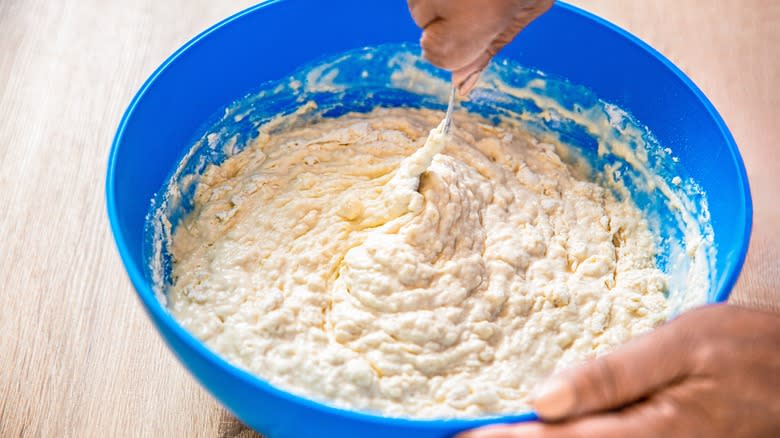
When mixing dough, your instinct might be to just mix and mix as hard as you can. You want to get everything incorporated, after all! However, this doesn't always lead to the best results. Overmixing your donut dough causes too much gluten to develop which, in turn, makes your donuts chewy and hard. They won't be fluffy like you want, and they may develop an odd, uneven surface that won't look very appealing.
Undermixing, on the other hand, will result in dough with a coarse, crumbly texture. Your donuts will not hold their shape when you go to fry them, and they will likely absorb too much of the frying oil, resulting in a greasy, odd-tasting donut.
To avoid both of these extremes, some donut makers recommend doing a "windowpane test" to check if they have mixed their dough long enough. This test consists of taking a little chunk of dough and stretching it between your fingers. If it forms a window-like membrane without breaking, it is perfect.
Mistake: Thinking That The Only Way To Shape Donuts Is With A Donut Cutter
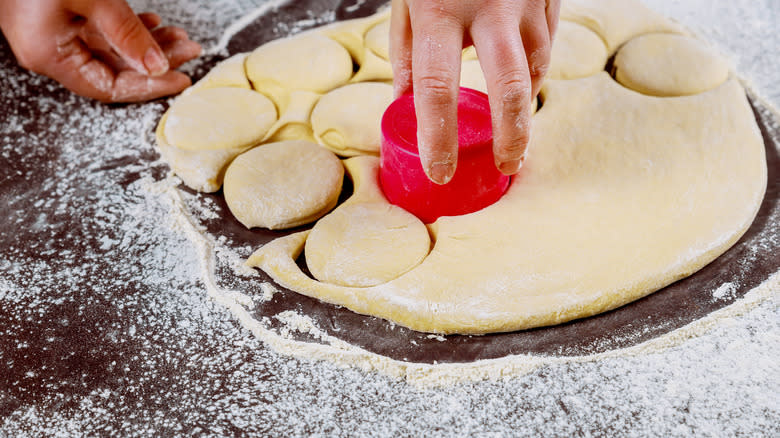
Has the fact that you don't have a donut cutter or a donut pan been holding you back from making homemade donuts? This is a common complaint, but after reading this, there will no longer be any reason not to give it a try. Chances are, you already have all you need in your kitchen. You can, for example, take two round cookie or biscuit cutters, one bigger and one smaller, and cut out the standard ring shape you need. If you don't have a small enough cookie cutter to make the hole in the center, look for something like a (cleaned) bottle cap or the larger, round side of a frosting tip.
Don't have a round cookie or biscuit cutter to make the larger part? Just use the rim of a glass or even the plastic cap from a can of Pam cooking spray. As long as it is sharp enough to cut through the dough, it will work. If all else fails, you can also just place something circular onto the dough and cut around it with a sharp knife. The dough will likely be stretchy and tough to cut, so this method will take some patience.
However, not every donut has a hole. So if you really can't find anything to help you cut out the shape you need, you can simply make donuts without holes. We promise, they taste the same!
Mistake: Frying Too Many Donuts At The Same Time
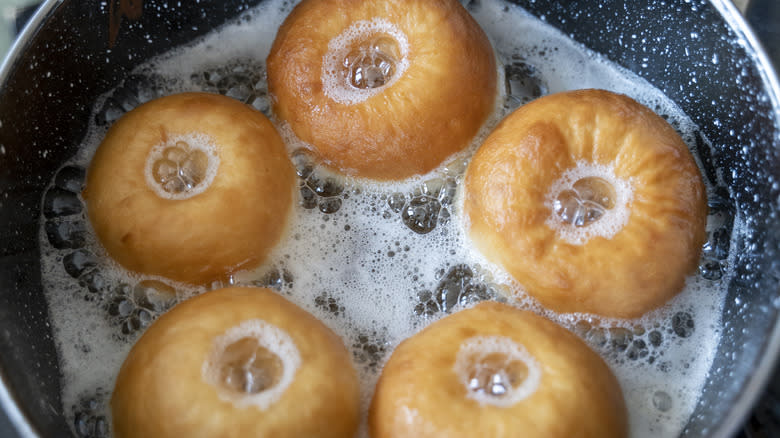
It is hard to be patient when you know that you will soon be rewarded with some delicious donuts. However, rushing things is never a good idea. Many people try to cut down on cooking time by putting as many donuts as possible into the frying pan, but this is not the best thing for your donuts.
Just like with other fried foods, it is important to allow some space between each donut so that they can cook evenly. If the pan is too crowded, the temperature of the oil will go too low, which means it will take longer for the donuts to cook. But it gets worse: The extended cooking time and incorrect oil temperature means that they will absorb more of the oil. This leads to dense, floppy donuts instead of the light, fluffy, crisp ones you were surely envisioning, so even if splitting things into two or three batches may take a little longer, it will undoubtedly be worth the wait.
Mistake: Not Using Hot Enough Oil
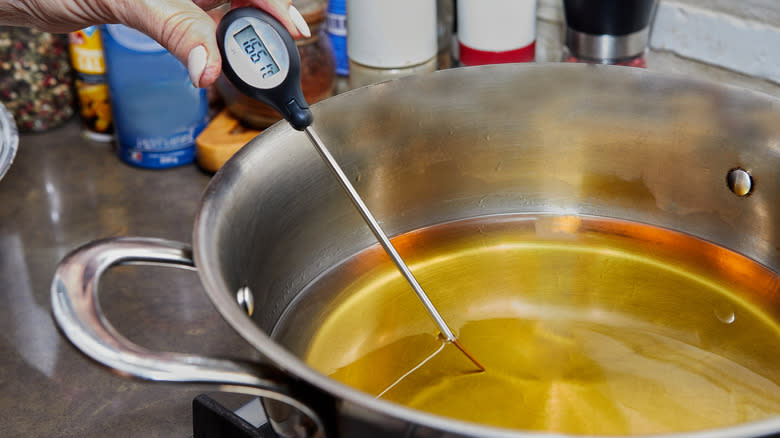
One of the things to always, always keep in mind when you're trying to make the perfect fried chicken is the temperature of the frying oil, and the same is true for when you are frying donuts. Even if donuts don't have raw meat in the center (at least, not the way we make them), they do still need to be cooked at a high and steady temperature in order to rise properly and become soft in the center and lightly crispy on the outside.
Your oil should be between 350 and 375 degrees F to ensure that your donuts are fried just right. The oil will inevitably cool slightly when you add the donuts, but ideally it should get back into this range fairly quickly. To take the guesswork out of it, you can check the temperature with a specialized thermometer before and during cooking to make sure that it doesn't get too high or too low. Some of these thermometers also have an alarm that you can set that will sound if the oil gets out of the set temperature range, which makes things even easier.
Mistake: Not Using Parchment Paper When Frying
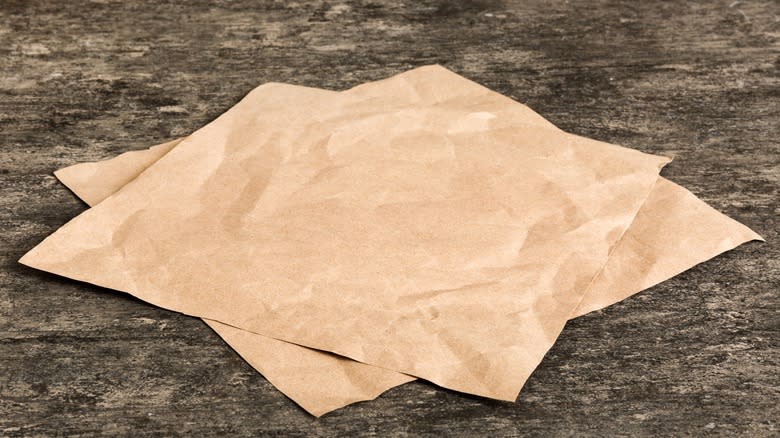
"Wait a second," you say, "parchment paper is for baking, not frying!" And to that we say, not so fast! Actually, it can be used for both.
If you are like many novice fryers, you might hesitate when adding your donuts to the pan of scalding-hot frying oil. And we don't blame you. If you're not careful, that oil can splash onto you, which can make for a very painful frying experience. Luckily, parchment paper can help prevent this splashback. All you have to do is to place your raw donuts onto squares of parchment paper. Then, use a slotted spoon or spatula to slowly slide both the donut and the parchment paper it's sitting on into the hot oil. The paper will come off as the donut cooks and can be picked out with some tongs, and the donut will be on its merry way to fried perfection.
This method also helps to ensure that your donut holds its shape when you pick it up to transfer it. It is especially useful for cake donuts, which have a thinner batter and are typically piped out with a piping bag. In this case, you can just pipe them onto the square of parchment paper and you're ready to go.
Mistake: Waiting Too Long To Decorate Your Donuts

Whether it's pink icing with rainbow sprinkles, a luscious chocolate glaze, or a dusting of cinnamon sugar, a donut's decoration is what grabs your attention first, and what brings out the delicious flavor of the donut beneath. If you want those decorations to stick, however, you have to act fast.
As soon as your donut is cool enough for you to touch, but still warm, it is time to add your toppings. If you wait too long, the glaze or sugar coating won't stick, and everything will just slide right off when someone goes to pick it up.
When adding a powdered sugar-based glaze, the best way to do so is to keep the glaze in a bowl and dip the donut into it, as opposed to pouring it over the donut, which can be messy. If you want to cover the donut completely, you can use a pair of chopsticks to flip the donut over a couple of times in the bowl of glaze to avoid getting your fingers too sticky.
Cinnamon sugar works best if you roll the donut in it and give it a gentle shake to get off the excess before putting it on the serving plate. You can also use a piping bag or a carefully held spoon to drizzle chocolate or to make streaks and stripes with various icing colors.
Mistake: Filling Donuts Too Soon
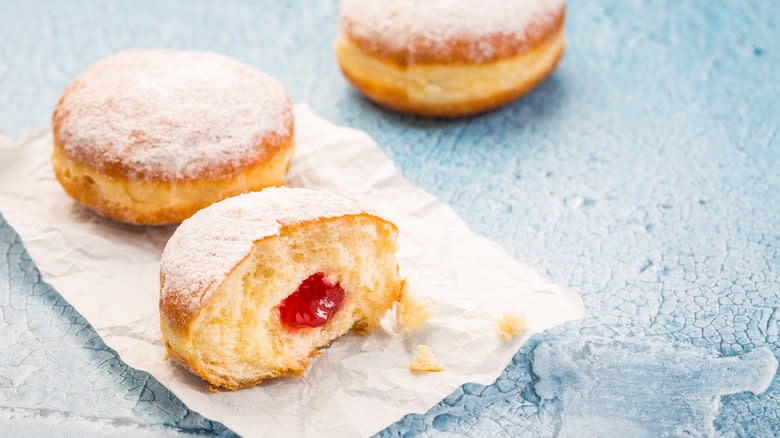
Whereas it is imperative to act fast when decorating the exterior of your donuts, filling their interior is best done after the flurry of frying has died down. Filling your donuts with cream or fruit jams or jellies when they are still hot causes that filling to melt. This means that it either leaks out or gets absorbed into the donut itself, leaving you with a pastry that seems hollow when it actually isn't. Heat can also cause some types of cream to separate, making them runny and unappealing.
In general, the best time to add a cream or jelly filling to your donut is after it has come to room temperature. It is also usually best to stick to filling fried donuts, as these have a lighter, more airy interior than the much denser cake donut and thusly have more space inside to hold cream.
To add the filling, you can create a small hole on the side or bottom of the donut with the tip of an icing bag and just pipe it right in. You can also inject it with a syringe with a wide tip and a thumb-operated plunger.
Read the original article on The Daily Meal.


